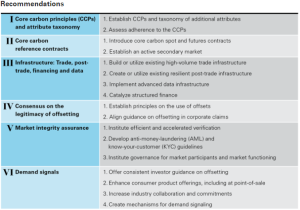Carbon Credit Exchanges
Carbon credit exchanges are the mechanism by which companies and other organizations can sell or save excess carbon credits, in order to keep emissions below their Cap & Trade limits. These systems are a key part of federally mandated carbon cap-and-trade programs.
There are two types of carbon markets: the regulatory market and the voluntary offset market. The regulatory market consists of government-mandated cap-and-trade programs in the US, Europe and China. Under these programs, each company is assigned a set number of credits to use to meet their emission limits. If the company emits more than the allowed amount of carbon, they are liable for fines and extra taxes.

Management teams that reduce their emissions below their limit can resell the surplus carbon credit exchange to a compliant company on their Cap & Trade network to make up for the extra emissions they are not responsible for. The resale of excess carbon credits in a carbon market is regulated by the appropriate authority, who sets the regulations and guidelines for the market.
Regulations of Carbon Credit Exchanges
As the climate change threat is becoming a greater focus for lawmakers and regulators around the world, interest in carbon market mechanisms is growing. This is in part due to the Paris Agreement, which gives nations an option to incorporate international markets into their Nationally Determined Contributions (NDCs), as well as an increased awareness of the benefits of such markets among policymakers.
One major challenge facing carbon market regulators is balancing market transparency and oversight with the ability of market participants to structure their contracts in a way that best fits their individual circumstances. As with all other market transactions, carbon trading on exchanges can be subject to certain requirements, such as position limits, clearing and collateral, reporting obligations, and restrictions on participation in certain types of transactions.
Voluntary carbon markets are more flexible, and allow for a wider range of projects. For example, international airlines participating in the Carbon Offsetting and Reduction Scheme for International Aviation (CORSIA) can buy carbon offsets from any project that meets the requirements of CORSIA’s standards.
However, a major concern with these systems is the risk of fraud and manipulation. There are several reasons why this is a concern, and one of them is that there are no stringent standards for quality assurance in the voluntary offset market.
The CFTC could take steps to prevent this from occurring by establishing more stringent standards for the voluntary carbon market, requiring that credits be registered before they can be sold. This would help ensure that the credits in question are genuinely additional or permanent, and not simply a shortcut for developers to get their projects registered without having to invest time and money in actual development.
This approach, which is being considered by the CFTC and the broader community of offsets traders, would also likely have a positive impact on prices in the voluntary market, as well. In a recent report, Platts noted that there were significant variations in prices between different carbon projects in the voluntary market, a phenomenon that can be caused by a lack of quality assurance in the sector.

